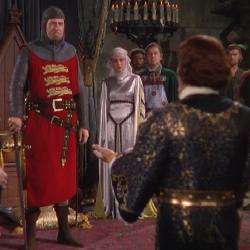The High Middle Ages
Stretching roughly from about the Norman Conquest (1066 and All That) to the early 1300s, but most often imagined as about the 12th or 13th century, this is Era of The Crusades, Robin Hood, and fat, lecherous, irascible, but good-hearted friars. Also home to knights, beautiful princesses with anachronistic hennins, and tall, spire-tipped Gothic architecture (note that most versions of the story of King Arthur are depicted as if they were set in this era, though strictly speaking he belongs to Late Antiquity). Expect to see a corrupt churchman or two wandering the landscape burning witches, heretics, and pretty much anyone who doesn’t agree with him.
In actual history, this is the high spot between the Vikings and the Black Death. The modern nations began to take shape, and with them the foundations of the legal system and government bureaucracy. The first great European universities were founded as a renaissance began flickering into life, and then disaster struck. A combination of internal strife and climactic disaster, capped by the Black Death, brought the brief golden age to an end. Whole villages were swallowed up by the advancing wilds as civilisation retreated.
It is probably because it ended so badly that this period is remembered so well, the halycon days before the Black Death stalked the land, hence the idealised popular image of this time, which hasn't changed much in five centuries.
The setting is likely to be a mythologized Britain or France, though there are examples from farther afield. Jerusalem, which had pretty much been ignored since Biblical Times will now also be used as the stage for all sorts of spectacular battles involving scimitar-wielding Saracens and sinisterly handsome Knights Templar.
See The Middle Ages for the more fantasticated version of this trope.
WARNING: Do not confuse with the French "Haut Moyen Age", which is a phrase literally meaning the same thing as "High Middle Ages" but refers to the period before (roughly from 450 AD to 1000 AD).
- Black Knight
- Christianity Is Catholic: Though it was throughout most of Central and Western Europe, in Eastern Europe and the Near East, Orthodoxy was more prevalent; yet is much less common in fictional works (and officially, the final split came as late as 1054).
- Courtly Love
- The Crusades: These are a perennially favorite backdrop for medieval fiction.
- Feudal Overlord
- Gorgeous Period Dress: Though most people, even the nobility, were dressed in wool except on the most festive occasions, Hollywood noblemen and (especially) noblewomen are resplendent in silks, satins, and velvets (which weren’t invented until late in the period) all the time.
- Historical Domain Character: Henry II of England, Eleanor of Aquitaine, and Richard the Lion Heart appear in a number of works set in this period.
- Historical Fiction: Due to the influence of Sir Walter Scott, this is one of the most common settings for this type of fiction.
- Knight in Shining Armor
- Lady and Knight
- Swashbuckler: Only slightly less common as a setting for these than The Cavalier Years.
- Warrior Monk: Not only were there may militant churchmen like Bishop Turpin in The Song of Roland, but this was the era of the military religious orders such as The Knights Hospitallers, The Knights Templar, and The Teutonic Knights.
Film
- Alexander Nevsky
- Becket
- Braveheart
- El Cid
- First Knight
- Any version of the story of Francis of Assisi (e.g., Brother Sun, Sister Moon; Francesco; or St. Francis of Assisi)
- Kingdom of Heaven
- The Lion in Winter
- Most TV and movie incarnations of Robin Hood (usually in the reign of Richard I, though most scholars now place him in the reigns of either Edward I or Edward II).
Literature
- Dante's Divine Comedy, sort of (Hell, Purgatory and Heaven are effectively other dimensions, but most of the characters Dante meets are his close contemporaries).
- Sir Walter Scott’s Ivanhoe (and all its film versions) and The Talisman (and its film version, King Richard and the Crusaders).
- Kristin Lavransdatter, a Nobel Prize-winning three-volume epic by Sigrid Undset, set in medieval Norway, is one of the most realistic depictions of this time period in fiction, especially interesting for its examination of feminism and religion in medieval life.
- Murder in the Cathedral
- The Pillars of the Earth is set during 'The Anarchy', the 12th-century English civil war between King Stephen and Empress Matilda.
- The Wild Hunt Trilogy is set during the reign of the sons of William the Conqueror.
- Eleanor: Crown Jewel of Aquitaine, France from The Royal Diaries series.
Live Action TV
- Robin of Sherwood, which is cited as being one of the most faithfully accurate depictions of this era in television history.
Theatre
- William Shakespeare’s King John, Richard II, Henry IV (Parts I and II), and Henry V (strictly speaking, Hamlet, Macbeth, and Romeo and Juliet should be, too, but they are very often performed in a quasi-Elizabethan setting).
Video Games
- The main campaign in Medieval II: Total War starts shortly after the Norman Conquest of England (in fact, the game tutorial is the Norman Conquest of England) and the bulk of the game takes place in the High Middle Ages.
- Paradox Interactive's Crusader Kings 4X games.
- Assassin's Creed
- The old Sierra adventure game Conquests of Camelot.
